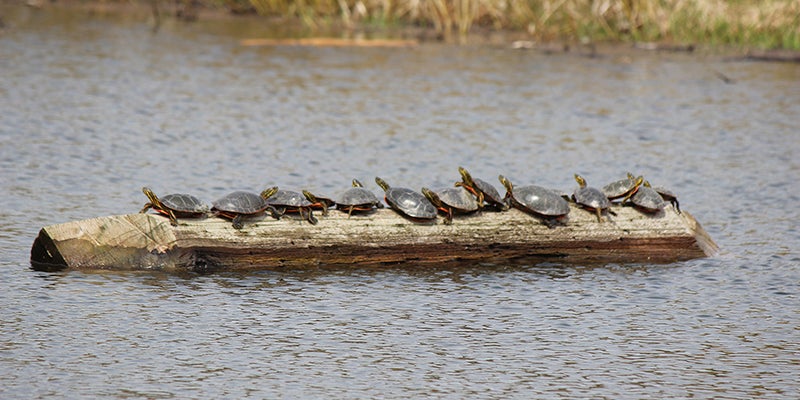Nature Notes: Slow down for the turtles!
Published 5:28 pm Friday, June 2, 2023

- Keep an eye out for turtles this spring. Photo provided
|
Getting your Trinity Audio player ready...
|
By Akiko Nakagawa
Jay C. Hormel Nature Center Intern/Naturalist
May brought hundreds of young learners to the Nature Center to learn all about different critters. A favorite in nearly every class were the turtles!
Seen basking on the logs in our pond or cutely swimming along with only their heads poking out of the water, the nature center is home to many, many turtles. Did you know Minnesota is home to nine species of native turtles? Three species of map turtles, two softshell turtles, the painted and snapping turtle, and finally two threatened species, the wood turtle and the Blanding’s turtle.
You might notice more turtles out and about on the road this month and wonder why they’ve left their usual wetland habitats — it’s because nesting season has arrived! Females are on the move to look for suitable grounds for laying their precious eggs. In the process, they may have to cross roads, so it’s important to slow down for turtles this month those ladies are on an important mission! Let’s take a deep dive into a favorite of the turtles amongst the staff here at the nature center, the Blanding’s turtle. The unique biology and life history of the Blanding’s turtle makes this wonderful species especially prone to consequences of human disturbance.
The Blanding’s turtle is a beautiful species with a significantly domed shell and a bright yellow chin and throat. They often have speckles of white or yellow on their shells too. Adults average between 6-9 inches, and they are found in calm, shallow waters where aquatic vegetation is plentiful and sandy uplands are nearby. With these very specific habitat requirements, Blanding’s turtles at all stages of life have been affected by habitat destruction and fragmentation. While you may be familiar with habitat destruction, let’s quickly talk about how habitat fragmentation can result in population declines. Habitat fragmentation occurs when parts of a habitat are destroyed, leaving smaller, disconnected areas of habitat behind. Habitat fragmentation leads to isolated populations, restricting gene flow. It also creates a larger area along the edges that are exposed to human activity. Think about it like this: if a habitat for a Blanding’s turtle is fragmented by the development of roads, a female turtle may have to cross multiple roads in order to find a suitable mate or nesting site, greatly increasing the risk of getting run over.
In addition to the destruction and fragmentation of their habitats, the life history of the Blanding’s turtle also makes them more prone to getting run over. Females can travel up to one mile from their resident wetland habitat to find suitable nesting sites. This is significantly longer than most other species of turtles, and increases the likelihood that she will be hit by a car while traveling. Additionally, Blanding’s turtles have a long development period and do not become sexually mature until they are 12 years of age. Therefore, if a mature female is killed while trying to cross a road, it may set back the local population for many years. These nesting sites that are far away from wetlands also threaten the survival of hatchlings — they will face similar car mortality, but are also at risk of desiccation and predation when traveling from the nesting site to nearby wetlands. However, high juvenile mortality is offset by how long adults can live to be — they may live up to 100 years old!
While Blanding’s turtles have been classified as a threatened species in Minnesota since 1984, the Minnesota DNR’s Nongame Wildlife Program has been working hard to conserve and protect this species. Their project focuses on surveying existing populations and establishing priority protection areas. If you’ve spotted a Blanding’s turtle, especially here in southern Minnesota, you can report it to the Nongame Wildlife Program and assist in their conservation efforts to save this incredible species! Happy June everyone, let’s slow down for the turtles this month!
Free June Events at the Nature Center
June 7: 4th Ave. Fest, Mill Pond free canoes and kayaks 5:30-7:30 p.m.
June 8: Senior Special, 10 a.m.; Family Program, 1 p.m.; Nature Play Free Activities, 1-4 p.m.
June 9: Cedar River Astronomy Club 8-10 p.m.
June 10: Sola Fide Observatory Open House, 9:30-11 a.m.
June 20: Free Kids Forestry Class (8-10 years), 9-10:30 a.m. Must RSVP
June 21: Volunteer Opportunity: Forest Preservation Work Party, Buckthorn Pull, 3:30-5 p.m.
June 22: Senior Special, 10 a.m.; Family Program, 1 p.m.; Nature Play Free Activities, 1-4 p.m.
June 23: Tree Container Presentation, 6-7 p.m.
June 24: Kids Tree Craft, 10 a.m. to 4 p.m.; Free Tree ID Class, 9:30-11 a.m. Must RSVP; Free Tree ID Class, 1-2:30 a.m. Must RSVP; Sola Fide Open House, 9:30-11 p.m.
June 28: Red Cross Blood Drive noon-6 p.m.


